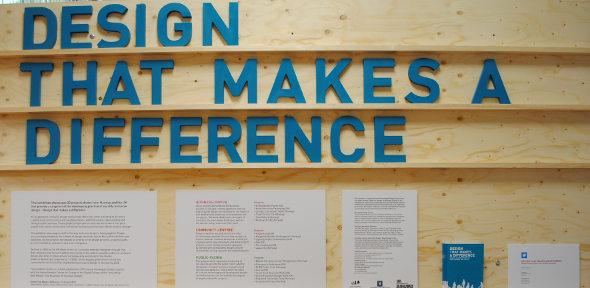
Dr Anna Mieczakowski and Professor John Clarkson from the Engineering Design Centre (EDC) were proud to bring to the Department the inspirational "Design that makes a difference" exhibition that debuted at the London Royal College of Art. This exhibition was jointly curated by the Royal College of Art and the Norwegian Design Council, long-term research collaborators of the EDC, and displayed two projects that used the EDC's Inclusive Design Toolkit during their design process - the BT Big Button Phone and Nestlé Inclusive Packaging.
The exhibition provided a snapshot of the developing practice of social design - design that makes a difference in putting people first, meeting social need, influencing business practice and effecting positive change.
Running from 8-12 July 2013, the exhibition was a great success, being attended by staff and students from the Department and the University, representatives from industry and policy organisations, and children from local schools.
The exhibition, showcasing 20 inclusive design projects from the UK and Norway, demonstrated the benefits of people-centred design thinking across sectors - from passenger trains and hotel chains to government websites, voting systems and community-led initiatives. Together they provided a snapshot of the developing practice of social design - design that makes a difference in putting people first, meeting social need, influencing business practice and effecting positive change.
The exhibition also mapped a shift in the way inclusive design is being applied. It emphasised that people are not simply viewed as the subject of design research, but as the authors of their own solutions. All the projects considered people as central to the design process, as participants, as commentators, evaluators and even instigators. Among these inspirational projects were:
- www.gov.uk, UK - The recently launched, public services, online portal for the UK government is designed with citizens in mind. It is based on 10 people-centred design principles and addresses around 950 user needs. It incorporates all government departments from the Foreign Office to the Ministry of Defence.
- Government Voting System: Blanke Ark, Norway - An inclusively designed election system that makes it easier for everyone to participate in democracy by reconsidering the ways that votes are cast. Everything from booths to ballot papers have been reimagined to allow people with different needs and abilities to access polling stations.
- Queen Elizabeth Olympic Park, UK - Maintaining the inclusive design legacy of the Queen Elizabeth Olympic Park is an important challenge for the London Legacy Development Corporation as it develops the site into new lifetime neighbourhoods and transforms existing venues following 'the most accessible Games ever'.
- Scandic Oslo Airport Hotel, Norway - When building a new hotel at Oslo international airport, the Scandic hotel chain used inclusive design to distinguish itself in the competitive tourism and travel sector. Guests can enjoy a chic yet functional interior, allergy-friendly materials, easy way finding and a more comfortable, welcoming experience.
- Emergency Ambulance, UK - A redesign of the interior of the emergency ambulance resulting in improved infection and stock control, more efficient treatment and better access to patients due to a repositioned stretcher. Co-designing with paramedics, patients, clinicians and engineers resulted in a full-size demonstrator prototype.
- NSB Flirt Public Train, Norway - Inclusive design was key to procurement and production of a new national train. Involving a wide range of people throughout the process resulted in attractive, accessible solutions for everyone, from flexible spaces to accommodate wheelchairs and luggage, to contrasting colours and tactile surfaces.
For more details about this exhibition, visit https://www-edc.eng.cam.ac.uk/gooddesign/
We would like to thank our kind sponsors - Centre for Science and Policy, The Raspberry Pi Foundation, University Computing Service and Kent House Consulting - for their help with bringing this exhibition to Cambridge.

